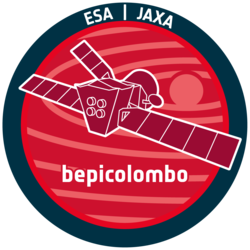
Back BepiColombo AN بيبيكولومبو Arabic BepiColombo BE BepiColombo Catalan BepiColombo Czech BepiColombo German BepiColombo Spanish BepiColombo ET BepiColombo EU بپیکلمبو FA
 Artist's depiction of the BepiColombo mission, with the Mercury Planetary Orbiter (left) and Mercury Magnetospheric Orbiter (right) | |
| Mission type | Planetary science |
|---|---|
| Operator | |
| COSPAR ID | 2018-080A |
| SATCAT no. | 43653 |
| Mission duration | Cruise: 7 years (planned) 8 years (actual) Science phase: 1 year (planned) 6 years, 2 months and 21 days (in progress) |
| Spacecraft properties | |
| Manufacturer | |
| Launch mass | 4,100 kg (9,000 lb) [1] |
| BOL mass | MPO: 1,230 kg (2,710 lb) Mio: 255 kg (562 lb) [1] |
| Dry mass | 2,700 kg (6,000 lb) [1] |
| Dimensions | MPO: 2.4 m × 2.2 m × 1.7 m (7 ft 10 in × 7 ft 3 in × 5 ft 7 in) Mio: 1.8 m × 1.1 m (5 ft 11 in × 3 ft 7 in) [1] |
| Power | MPO: 150 watts Mio: 90 watts |
| Start of mission | |
| Launch date | 20 October 2018, 01:45 UTC |
| Rocket | Ariane 5 ECA (VA245)[2] |
| Launch site | Centre Spatial Guyanais, ELA-3[3] |
| Contractor | Arianespace |
| Flyby of Earth (gravity assist) | |
| Closest approach | 10 April 2020, 04:25 UTC |
| Distance | 12,677 km (7,877 mi) |
| Flyby of Venus (gravity assist) | |
| Closest approach | 15 October 2020, 03:58 UTC |
| Distance | 10,720 km (6,660 mi) |
| Flyby of Venus (gravity assist) | |
| Closest approach | 10 August 2021, 13:51 UTC |
| Distance | 552 km (343 mi) |
| Flyby of Mercury (gravity assist) | |
| Closest approach | 1 October 2021, 23:34:41 UTC |
| Distance | 199 km (124 mi) |
| Flyby of Mercury (gravity assist) | |
| Closest approach | 23 June 2022, 09:44 UTC |
| Distance | 200 km (124.3 mi) |
| Flyby of Mercury (gravity assist) | |
| Closest approach | 19 June 2023, 19:34 UTC |
| Distance | 236 km (147 mi) |
| Flyby of Mercury (gravity assist) | |
| Closest approach | 4 September 2024, 21:48 UTC |
| Distance | 165 km (103 mi) |
| Flyby of Mercury (gravity assist) | |
| Closest approach | 1 December 2024, 14:23 UTC |
| Distance | 37,626 km (23,380 mi) |
| Flyby of Mercury (gravity assist) | |
| Closest approach | 8 January 2025, 05:59 UTC |
| Distance | 295 km (183 mi) |
| Mercury orbiter | |
| Spacecraft component | Mercury Planetary Orbiter (MPO) |
| Orbital insertion | November 2026 (planned) |
| Orbital parameters | |
| Perihermion altitude | 480 km (300 mi) |
| Apohermion altitude | 1,500 km (930 mi) |
| Inclination | 90,0° |
| Mercury orbiter | |
| Spacecraft component | Mercury Magnetospheric Orbiter (MMO) |
| Orbital insertion | November 2026 (planned) |
| Orbital parameters | |
| Perihermion altitude | 590 km (370 mi) |
| Apohermion altitude | 11,640 km (7,230 mi) |
| Inclination | 90.0° |
 BepiColombo insignia | |
BepiColombo is a joint mission of the European Space Agency (ESA) and the Japan Aerospace Exploration Agency (JAXA) to the planet Mercury.[4] The mission comprises two satellites launched together: the Mercury Planetary Orbiter (MPO) and Mio (Mercury Magnetospheric Orbiter, MMO).[5] The mission will perform a comprehensive study of Mercury, including characterization of its magnetic field, magnetosphere, and both interior and surface structure. It was launched on an Ariane 5[2] rocket on 20 October 2018 at 01:45 UTC, with an arrival at Mercury planned for November 2026, after a flyby of Earth, two flybys of Venus, and six flybys of Mercury.[1][6] The mission was approved in November 2009, after years in proposal and planning as part of the European Space Agency's Horizon 2000+ programme;[7] it is the last mission of the programme to be launched.[8]
On 15 May 2024, ESA reported that a "glitch" prevented the spacecraft's thrusters from operating at full power during a scheduled manoeuvre on 26 April.[9] On 2 September, ESA reported that to compensate for the reduced available thrust, a revised trajectory had been developed that would add 11 months to the cruise, delaying the expected arrival date from 5 December 2025 to November 2026.[10]
- ^ a b c d e "BepiColombo Factsheet". ESA. 6 July 2017. Retrieved 6 July 2017.
- ^ a b "BepiColombo's first image from space". ESA. 10 October 2018.
- ^ "MIO/BepiColombo". JAXA. 2018. Retrieved 9 July 2018.
- ^ Amos, Jonathan (18 January 2008). "European probe aims for Mercury". BBC News. Retrieved 21 January 2008.
- ^ "MIO – Mercury Magnetospheric Orbiter's New Name" (Press release). JAXA. 8 June 2018. Retrieved 9 June 2018.
- ^ "BepiColombo Launch Rescheduled for October 2018". ESA. 25 November 2016. Retrieved 14 December 2016.
- ^ "BepiColombo Overview". ESA. 5 September 2016. Retrieved 13 March 2017.
- ^ Cite error: The named reference
scaling backwas invoked but never defined (see the help page). - ^ "Glitch on BepiColombo: work ongoing to restore spacecraft to full thrust". ESA. 15 May 2024. Retrieved 29 May 2024.
- ^ "Fourth Mercury flyby begins BepiColombo's new trajectory". ESA. 2 September 2024. Retrieved 2 September 2024.